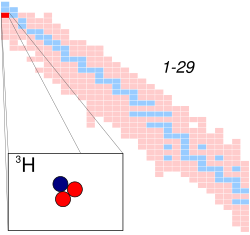| Hydrogen-3 | |||
|---|---|---|---|
 | |||
| General | |||
| Name, symbol | tritium, triton, 3H | ||
| Neutrons | 2 | ||
| Protons | 1 | ||
| Nuclide Data | |||
| Natural abundance | trace | ||
| Half-life | 12.32 years | ||
| Decay products | helium-3 | ||
| Isotope mass | 3.0160492 u | ||
| Spin | 1/2+ | ||
| Excess energy | 14949.794 ± 0.001 keV | ||
| Binding energy | 8481.821 ± 0.004 keV | ||
| Mode | Intensity | Energy | |
| β- | 100% | 0.018590 MeV | |
Sources
editAll isotope data
Isotopes listed
editA hard line of listed isotopes are those with half-lives of 24 hours or greater. This is done because the average person would have no chance of coming into contact with any other isotopes. If there is contact it would have no impact on their lives. A softening of the line exists in the listing of isotopes with shorter half-lives that are likely to come into contact with "normal persons". A normal person is a non-nuclear worker.
Decay methods
editA decay methods is listed as occurring if its branching percentage is greater than 3% of any particular energy level. If the sum of branching for a particular decay method is greater than 3% but an individual energy does not have a 3% occurrence, the decay method is not listed as occurring. However, there is one caveat. If there is only one decay method (other than gamma emission) then the decay method is listed as occurring anyway.
Decay Emission Energy
editOnly decay energies with an occurrence of greater than 3% are listed as occurring. Electron capture is not listed as having any decay energy because there is no actual emission of anything other than neutrinos. If there are more than four applicable decay energies only the top occurring four are listed, in interest of space.
Daughter Products
editGamma emissions are not listed as having a daughter product because a gamma emission is a release of excess energy without any other nuclear transformation. An internal conversion emssion on the other hand does have the ground-state as a daughter product.